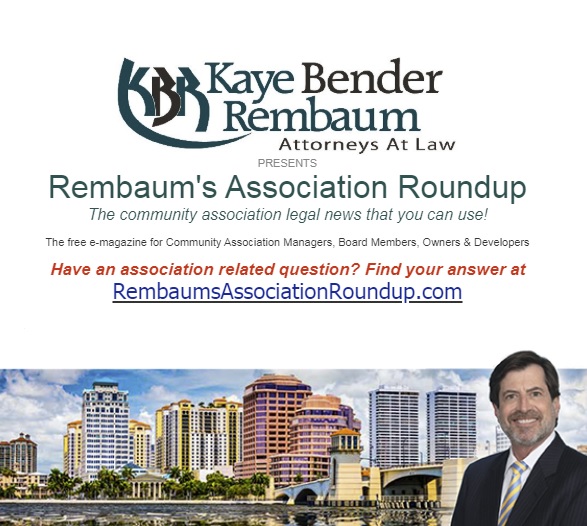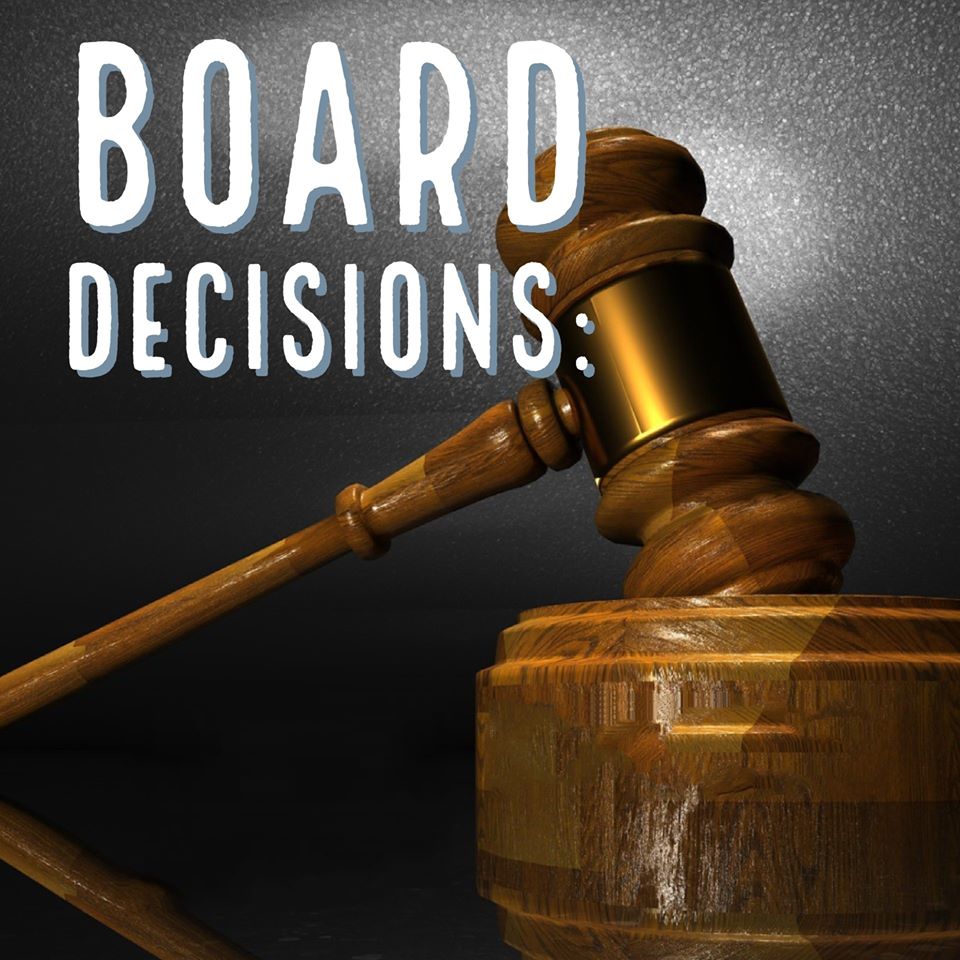DOS AND DON’TS OF ELECTION CHALLENGES by Rembaum’s Association Roundup
DOS AND DON’TS OF ELECTION CHALLENGES
Pursuant to their relevant statutory provisions, election disputes that take place in condominium, homeowners’, and cooperative associations are subject to mandatory nonbinding arbitration before the Division of Florida Condominiums, Timeshares, and Mobile Homes (the “Division,” for short). It is referred to as “nonbinding” because the arbitrator’s order is not final until 30 days after its issuance, which provides time for either party in the dispute to challenge the decision to their local circuit court, which hears the case de novo (anew).
As you will read, not every election dispute will be heard by the Division. As a threshold matter of importance, the Division will not hear election disputes within 60 days prior to an election or 60 days after the election has taken place. In order to bring an election challenge, Florida Statutes require prior written notice to the other party of the dispute, where a reasonable opportunity to correct the alleged error is provided, and it is clearly expressed that if the alleged error is not cured, an arbitration action will take place. In a prior arbitration case, it was held that providing only 10 days to cure the alleged defect in a pre-arbitration notice was insufficient. Therefore, it is suggested to provide more than 10 days opportunity to cure the alleged election defect prior to filing an action for arbitration.
Interestingly, the general rule is that to have standing to challenge election results, arbitration action must be brought by a candidate or an individual who was prevented from being a candidate. The Division has even held that a member who was not a candidate did not have standing to challenge the election results that other persons should have been declared the winning candidates. While these arbitration decisions are not binding precedent, they are instructive and, if nothing else, useful in evaluating the best course of action.
In the context of condominium election challenges, there are three flaws that are typically “fatal” to the association, if committed. They are i) a substantive or serious defect in the first notice of election, ii) the failure to include a timely submitted candidate information sheet in the second notice of election, and iii) failure to include the name of each eligible candidate on the election ballot. While each of these can potentially be timely cured in advance of the election, if not, then they likely lead to a successful election challenge.
For example, failing to mail the notice of election to one or more owners or the failure of the first or second notice of election to accurately state the street address of the meeting have been considered as “fatal” flaws. Also, the failure to include a timely submitted candidate information sheet or failure to include the name of a candidate on the ballot have also been considered as “fatal” flaws. However, so long as the election is re-noticed from the second notice of election, including all of the candidate and information sheets and/or also including the name of all of the candidates on the ballot, then such fatal flaws can be cured in advance of the election. In these instances there would be no further solicitation of candidates, but rather a rescheduling of the night of the election itself by sending a revised and corrected second notice of election at least 14 days prior to the election which would cure that defect. This amended second notice should clearly state the reason(s) for having to send the corrected notice.
It is important to note that while condominium association elections are strictly construed in accordance with relevant Florida Statutes, homeowners’ association elections occur in accordance with their governing documents. Therefore, whether the above fatal flaws have applicability to a homeowners’ association fully depends upon the style of election set out within the governing documents.
Arbitrators with the Division have held that a new election will have to be scheduled if in the governing documents there is included a requirement that candidates be full-time residents of the state of Florida or even reside in their unit full time and such requirements were enforced during the election. Therefore, there cannot be a residency requirement of any kind for board members. Similarly, arbitrators have held that associations cannot require candidates to complete a criminal background check or even execute an acknowledgment that they are not a felon.
Contrary to popular belief, the relevant Florida Statutes do not require candidates to be members of a community association in order to run for the board of directors (often, “membership” is defined in the governing documents as being an owner of a parcel within the community). However, such requirements can be set out in the governing documents; but if such a requirement is not in the governing documents, then the board cannot disqualify a potential candidate because he or she is not an owner or member. This means that without such requirements specifically set forth in the governing documents of the association, any non-member, including tenants and occupants, are qualified to run for the board of directors. Therefore, if you desire to avoid such a circumstance, you should consult with legal counsel for your association regarding whether such requirements exist in the governing documents; if not, then you should consider preparing an amendment for the community to approve to ensure that only members who are actual members/owners of the association are qualified to run and serve on the board.
As to the first notice of election, notwithstanding any strict requirements set out in the first notice of election regarding where potential candidates must submit their notice of candidacy, it is not sufficient to exclude a candidate on the basis of the candidate delivering his or her intent to be a candidate elsewhere so long as it is reasonable to conclude the association actually received notice of such candidate’s intent to run for the board. For example, a specific address could be required to mail the intent to run form, but the fact that a candidate hand-delivered such notice to a board member or manager would likely not be sufficient grounds to exclude the candidate.
Through a variety of arbitration decisions, the arbitrators have made clear that if the violation at hand would not have changed the results of the election, then the challenge will fail. For example, an association that improperly excluded several ballots due to perceived flaws with the outer envelope, which in fact were later held not to be flaws at all and which if counted would not have overturned the otherwise valid election results if the ballots were later included in the total count, would not have changed the result.
In other instances where numerous violations combine to clearly affect the reliability of the election results, then an election challenge may be valid. For example, where unit owners are permitted to cast ballots without inner envelopes, at least one owner was permitted to retrieve his ballot and change it, and nobody verified signatures on the outer ballot envelopes and where at least one unit owner was allowed to cast a ballot after the polls had already closed, then cumulatively the election results were determined to be no longer reliable and a new election was required.
While the Division has promulgated condominium election rules in the Florida Administrative Code, it has not yet done so for homeowners’ associations. Therefore, the body of condominium arbitration decisions can provide some guidance; but for the most part, when examining homeowners’ association election challenges, the arbitrators are required to consider the significance and totality of violations in their decision-making as to whether to void an election, or not.
At times, for reasons that really do not make any practical sense, some management companies when preparing a homeowners’ association election revert back to the condominium form of election with a first notice, second notice, intent to run, etc. rather than relying on the homeowners’ association governing documents, which have a completely different election style and where voting is by proxy or in person. Also, there are no requirements to declare candidacy in advance of the annual election, meaning a candidate could actually nominate himself or herself from the floor of the meeting on the election day itself. When management companies go on autopilot and use the condominium style of election contrary to the requirements set out in the homeowners’ association governing documents, then the arbitrators will likely require a new election to take place in conformity with the governing documents of the homeowners’ association.
A successful challenge of a homeowners’ association election often rests upon whether the alleged violation affected the outcome of the election. This once again is evidence that unless the alleged violation would have changed the outcome of the election, then the election challenge likely fails even if there were serious irregularities during the election process.
A few odds and ends are worthy of discussion as well. An active board of directors should not use the association’s pulpit for campaigning. Doing so can lead to a successful election challenge. However, an existing board member can certainly campaign on his or her own time and using their own means but not through the association or its website. If the association has not enforced use of voting certificates, then to do so without providing advanced written notice and an opportunity for the owners to comply could invalidate election results. Finally, if a valid election does not occur because either a quorum was not achieved or in the condominium context at least 20 percent of the eligible voters did not cast the ballot, then there is no obligation of the association to try again.
When bringing an election challenge is under consideration, ask yourself if the irregularity would have brought about a change in the outcome of the election. If not, then, think twice about bringing the challenge. In any event, it is worthwhile for an association concerned with its election process to consult with the association’s lawyer for a detailed conversation as to how best to avoid such problems in the future.
Tags: Condo and HOA Law, Elections


 Many associations are considering whether to adopt online voting (or “E-Voting”). Legislation took effect enacting Section 718.128, back in July 2015. Florida Statutes, permitting condominiums, cooperatives and homeowners’ associations to conduct elections and other owner votes through the use of “an Internet-based online voting system.” This article will discuss how to do so and what the advantages are.
Many associations are considering whether to adopt online voting (or “E-Voting”). Legislation took effect enacting Section 718.128, back in July 2015. Florida Statutes, permitting condominiums, cooperatives and homeowners’ associations to conduct elections and other owner votes through the use of “an Internet-based online voting system.” This article will discuss how to do so and what the advantages are.


 In a condominium, it’s much easier than an HOA to run the election with social distancing because the procedures allow for mail-in ballots. The association must still have an in person “annual meeting” but it can be very small, with only a few people showing up while everyone else tunes in to watch live on their computer.
In a condominium, it’s much easier than an HOA to run the election with social distancing because the procedures allow for mail-in ballots. The association must still have an in person “annual meeting” but it can be very small, with only a few people showing up while everyone else tunes in to watch live on their computer.



